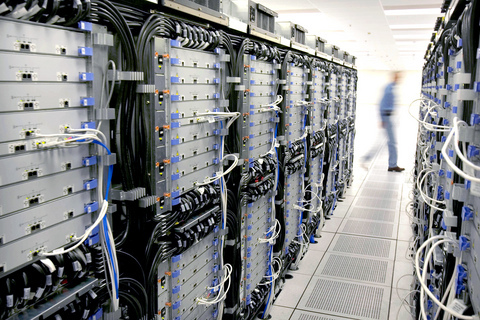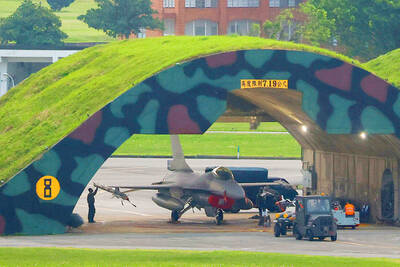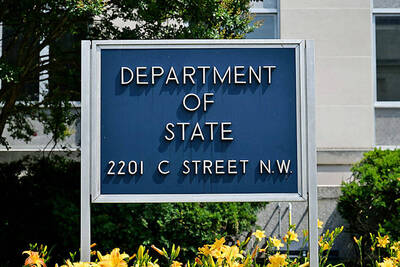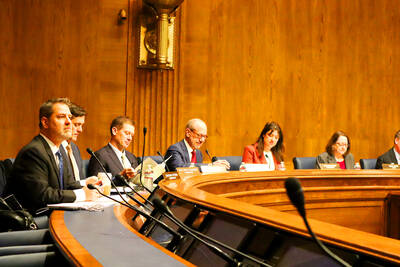A global race is under way to reach the next milestone in supercomputer performance, many times the speed of today's most powerful machines.
And beyond the customary rivalry in the field between the US and Japan, there is a new entrant -- China -- eager to showcase its arrival as an economic powerhouse.
The new supercomputers will not be in use until the end of the decade at the earliest, but they are increasingly being viewed as crucial investments for progress in science, advanced technologies and national security.

PHOTO: NY TIMES
Once the exclusive territory of nuclear weapons designers and code breakers, ultrafast computers are increasingly being used in everyday product design. Procter & Gamble used a supercomputer to study the airflow over its Pringles potato chips -- to help stop them from fluttering off the assembly lines.
Today, driven by advances in so-called parallel computing -- with software making it possible to lash together arrays of tens of thousands or even hundreds of thousands of processor chips -- the speed of future supercomputers is limited only by cost, adequate electricity and the ability to cool the systems, which nowadays can sprawl over thousands of square meters.
China now has 19 supercomputers ranked among the 500 fastest machines, and recent reports in Chinese newspapers stressed the importance of developing high-performance computing technology not dependent on the US.
"It's becoming an issue of national pride," said Steve Wallach, a supercomputer designer who is a vice president at Chiaro Networks, a technology provider for high-performance computing. "That's where the Japanese are coming from, and now the Chinese want to be viewed as a Tier 1 country in every respect."
Indeed, in recent weeks there have been reports that both the Japanese and Chinese are planning new investments in breaking the petaflop computing barrier. A petaflop is a measure of computing performance that describes the ability to perform 1,000 trillion mathematical operations a second, roughly eight times the speed of today's fastest computer.
"Everyone appears to be in the race for a petaflop," said Jack Dongarra, a computer scientist at the University of Tennessee who maintains a list of the world's fastest computers.
Currently the world's fastest computer is a machine installed at Lawrence Livermore National Laboratory late last year -- and still growing -- that has reached more than 136 trillion operations a second, or 100,000 times the speed of a fast desktop personal computer. IBM built the machine, Blue Gene/L, and plans to double its speed before the end of the year.
Only small amounts of research funds have been spent so far on designing a petaflop supercomputer, an accomplishment that Japanese and American experts believe will cost nearly US$1 billion for each machine to achieve. But 10 companies have indicated that they are doing preliminary work, Dongarra said.
In the US, Cray, IBM and Sun Microsystems have begun work toward reaching a petaflop by the end of the decade, supported by a development project financed by the Pentagon.
The project, the High Productivity Computer Systems program of the Defense Advanced Research Projects Agency, or DARPA, was begun in 2003 with about US$150 million as one of a series of US responses to the emergence of a Japanese supercomputer -- the Earth Simulator, intended for climate research -- as the world's fastest in 2002, displacing the US for the first time.
With significant financial support from the government, IBM, Cray and Silicon Graphics all built new massively parallel supercomputers, enabling the US to recapture world leadership in November last year.
As a result, in the most recent ranking of the world's 500 fastest computers, released in June, the US holds the top three positions. The Earth Simulator has fallen to fourth place, with about a quarter the computing speed of the new leader.
Some executives say they believe the US is well positioned to remain dominant in computing technologies.
"There is a lot less angst in the US than there was previously," said David Turek, vice president for high-performance computing at IBM. "We're not asleep at the switch."
But the fastest American machines are used primarily for military applications at the nation's weapons laboratories. Many scientists and technology executives in the US are concerned about losing out in crucial markets like oil and gas exploration, automobile design and manufacturing unless they, too, have access to the fastest supercomputers. They contend that a public-private partnership is needed to develop supercomputers whose applications are not limited to the military.
Not all supercomputer experts are convinced that having the world's fastest computer is essential to American competitiveness.
"IBM and Cray are doing a good job of ensuring that the US remains competitive in the high-performance computing market," said C. Gordon Bell, a Microsoft researcher and a former supercomputer designer.
Because the very largest computers are so difficult to program, their impact in the short term is relatively limited, he added.
But in April, the Japanese Automobile Manufacturers Association reported that the Earth Simulator had been used by automotive engineers to greatly increase the speed and resolution of car-crash simulations, potentially offering a significant reduction in development time for new car models.
That has alarmed some US industry executives, who argue that high-performance computing is now decisive in industrial competitiveness.
"This is a subtle but important change in the competitiveness game," said Suzy Tichenor, vice president for high-performance computing projects at the Council on Competitiveness in Washington.
Last month in China, Lenovo Group, which acquired IBM's personal computer business last year, said it would join in a Chinese effort to build a petaflop machine by 2010 as part of a five-year government plan to advance the country's computer technology. Separately, two other Chinese companies, Dawning and Galactic Computing, have indicated they intend to develop petaflop-scale systems.
A French military program, led by the French computer maker Bull, has plans to reach a petaflop in 2013.
And already there is discussion of frontiers beyond a petaflop. Several Japanese newspapers have reported in the last month that the Japanese government is expected to announce a commitment to developing a 10-petaflop supercomputer as a follow-up to the Earth Simulator.
Separately, the Japanese computer maker Fujitsu said last month that it planned a three-petaflop computer, and the director of the Earth Simulator told <
The system will employ two computers, one for rough calculations and another for more precise computing, providing more efficiency than today's massively parallel machines.
While the US has regained the lead in supercomputing achievement, its researchers have benefited unevenly. The armed forces and intelligence agencies have traditionally commanded the very largest computing systems here, for example, while other countries have devoted their speediest computers to other efforts, notably research on climate change.
"These machines can be used to answer questions that literally will mean the life or death of humanity," said Peter Freeman, assistant director for computer and information sciences and engineering for the National Science Foundation. "Currently the data the United States has at its disposal is not as good as what the Japanese have. It's a national strategy question."

MISINFORMATION: The generated content tends to adopt China’s official stance, such as ‘Taiwan is currently governed by the Chinese central government,’ the NSB said Five China-developed artificial intelligence (AI) language models exhibit cybersecurity risks and content biases, an inspection conducted by the National Security Bureau (NSB) showed. The five AI tools are: DeepSeek, Doubao (豆包), Yiyan (文心一言), Tongyi (通義千問) and Yuanbao (騰訊元寶), the bureau said, advising people to remain vigilant to protect personal data privacy and corporate business secrets. The NSB said it, in accordance with the National Intelligence Services Act (國家情報工作法), has reviewed international cybersecurity reports and intelligence, and coordinated with the Ministry of Justice Investigation Bureau and the National Police Agency’s Criminal Investigation Bureau to conduct an inspection of China-made AI language

BOOST IN CONFIDENCE: The sale sends a clear message of support for Taiwan and dispels rumors that US President Donald Trump ‘sold out’ the nation, an expert said The US government on Thursday announced a possible sale to Taiwan of fighter jet parts, which was estimated to cost about US$330 million, in a move that an expert said “sends a clear message of support for Taiwan” amid fears that Washington might be wavering in its attitude toward Taipei. It was the first announcement of an arms sale to Taiwan since US President Donald Trump returned to the White House earlier this year. The proposed package includes non-standard components, spare and repair parts, consumables and accessories, as well repair and return support for the F-16, C-130 and Indigenous Defense Fighter aircraft,

CHECKING BOUNDARIES: China wants to disrupt solidarity among democracies and test their red lines, but it is instead pushing nations to become more united, an expert said The US Department of State on Friday expressed deep concern over a Chinese public security agency’s investigation into Legislator Puma Shen (沈伯洋) for “secession.” “China’s actions threaten free speech and erode norms that have underpinned the cross-strait ‘status quo’ for decades,” a US Department of State spokesperson said. The Chongqing Municipal Public Security Bureau late last month listed Shen as “wanted” and launched an investigation into alleged “secession-related” criminal activities, including his founding of the Kuma Academy, a civil defense organization that prepares people for an invasion by China. The spokesperson said that the US was “deeply concerned” about the bureau investigating Shen

LIMITS: While China increases military pressure on Taiwan and expands its use of cognitive warfare, it is unwilling to target tech supply chains, the report said US and Taiwan military officials have warned that the Chinese People’s Liberation Army (PLA) could implement a blockade within “a matter of hours” and need only “minimal conversion time” prior to an attack on Taiwan, a report released on Tuesday by the US Senate’s China Economic and Security Review Commission said. “While there is no indication that China is planning an imminent attack, the United States and its allies and partners can no longer assume that a Taiwan contingency is a distant possibility for which they would have ample time to prepare,” it said. The commission made the comments in its annual